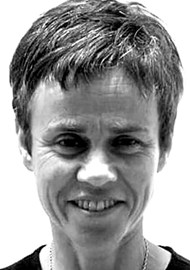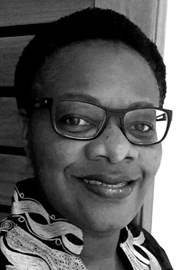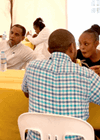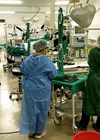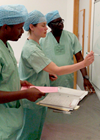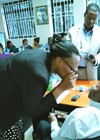Global Citizen post - a new challenge
I was looking for a new challenge. I had been in the same consultant post with a subspecialty interest in paediatrics and strabismus for 17 years and was rattling around in an empty nest. At the RCOphth Congress in 2019 I learnt of a novel proposed post. Andy Pyott, a Consultant Ophthalmologist from Inverness, outlined his hope to create a Global Citizen Consultant Ophthalmologist post.
Global citizen consultant posts are a Scottish initiative. Currently there is one other doctor in a similar post in medicine. The proposed job plan was: 12 weeks a year in Orkney, four weeks in Lewis, 16 weeks in Inverness and 10 weeks overseas in a low- or middle-income country (LMIC). I was immediately hooked - as soon as the session finished, I charged up to Andy and expressed my interest.
I had previous experience in training and capacity-strengthening in LMICs. For many years I coordinated two VISION 2020 LINKS from my base at the Western Health and Social Care Trust in Northern Ireland. The first started in 2009 with a small, independent eye hospital in Kano, Nigeria. When travel there was limited by Boko Haram, we formed a second LINK in 2013 with a government hospital in Mbeya, Tanzania. Building a long-term relationship with a department allows achievable goals to be set, reached and sustained.
I therefore wrote to the Ministry of Health in Tanzania outlining a proposal to support ophthalmology departments in government hospitals in Mwanza, Dodoma and Mbeya for 10-week visits annually. Bernadetha Shilio, National Eye Care Program Manager at the Ministry of Health, Community Development, Gender, Elderly and Children, vouched her support, so I presented this plan at my interview.
Global Citizen in the Highlands and Islands
I have now been in post for nearly two years. It was strange to take up a new post in a new country in October 2020 in the midst of the pandemic and only be able to see people’s eyes because of their masks. I was lucky that patient numbers were low at that time as I struggled with the unfamiliar IT systems, which are different in each of the three health services I now work in.
Remote working is challenging. For the first time I had to make anti-VEGF decisions when managing patients in Orkney. The team at Raigmore Hospital in Inverness gave me tutorials and helped me to set up protocols.
At Raigmore, I established specialist clinics for cornea and neuro-ophthalmology. I was surprised and delighted to see how quickly everyone moved to enable this. New clinic templates were created, and the supporting optometrists, orthoptists and visual field technicians provided. A corneal-focused optometrist and I went to Gartnavel General Hospital in Glasgow to meet the corneal team, so we would know when and how to make timely and appropriate referrals. I also met a neuro-ophthalmologist who gave me a protocol for investigating unexplained optic atrophy.
Global Citizen Consultant Ophthalmologist - excerpt from the job advert:
“This is a permanent, fulltime, Global Citizen Consultant post in General Ophthalmology working in NHS Highland, NHS Orkney, and NHS Western Isles. The post provides 10 weeks each year working overseas, and 32 weeks each year working in NHS Scotland. This is an innovative approach bringing global and local health together, and will suit those who want to be an active global citizen, advancing both personal and professional development, whilst contributing to improved access to health overseas. It is expected that the post will appeal to those who enjoy the challenges of remote and rural working, the beauty of the north of Scotland, and those with a desire to use their skills to benefit less privileged communities.”
Both of those teams have remained available since, with prompt advice. Doing a corneal clinic in the morning and a neuro-ophthalmology clinic in the afternoon is chalk and cheese: counselling a post-penetrating keratoplasty (PKP) patient for cataract surgery, wondering if a very low vitamin D is sufficient to cause the optic neuropathy. My journal reading choices have broadened significantly.
My new playgrounds include excellent coastlines for kayaking, loads of snow in my first winter for ski touring, cold lochs and white beaches for swimming. I’m making inroads into the Munros and have found new people with whom to play chamber music.
Global Citizen in Tanzania
I have now spent two 10-week periods working in Tanzania. During my visit to Tanzania in 2021 I spent two weeks at Benjamin Mkapa Hospital, Dodoma, then three weeks at Bugando Medical Centre, Mwanza, followed by two weeks at KCMC, Moshi and finally two weeks on outreach with a KCMC paediatric ophthalmology team to Songea. In each of the units I found people who were keen to engage with me clinically and learn new skills. For me it was a valuable scoping exercise to see where my focus might be over the following years.
One of the key areas identified in 2021 was the desire of units to strengthen their diabetic eye screening and patient management. During my second visit in 2022 I worked with staff in four centres - Dodoma, Mbeya, Mwanza and Muhimbili - to help them access and use iTAT, a valuable training and quality assurance tool for graders [1].
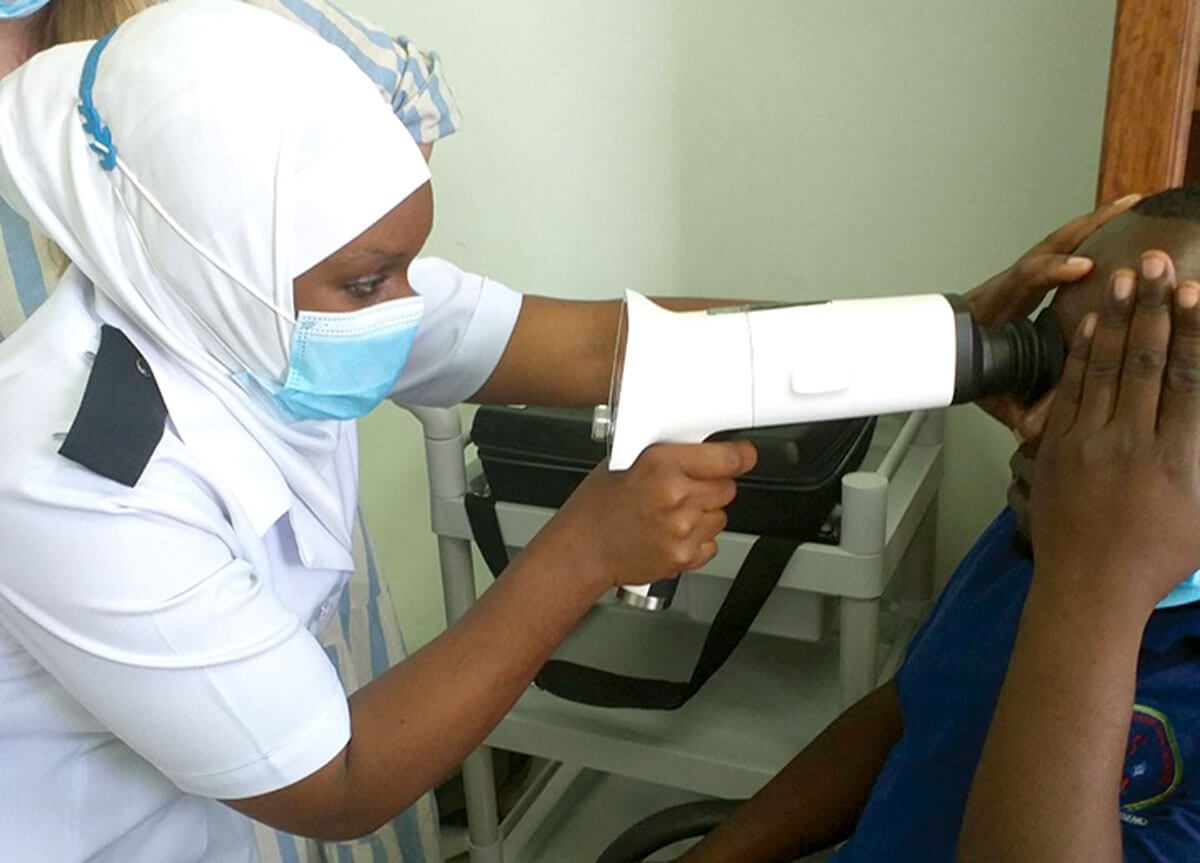
Staff nurse Shamin Haroun using the Optomed fundus camera for diabetic screening in Dodoma.
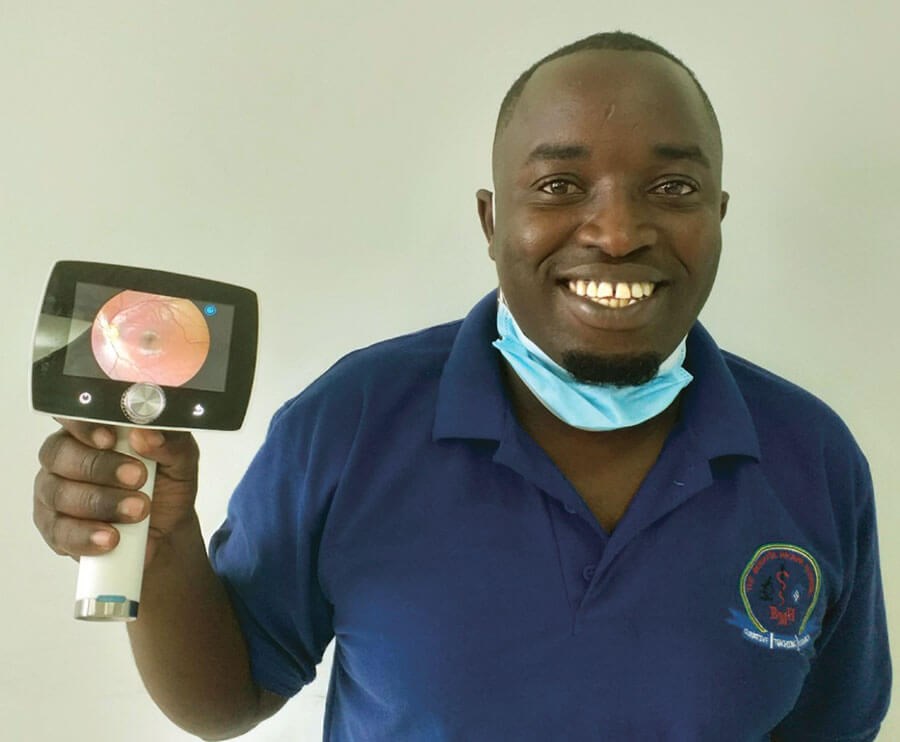
Staff Nurse Charles Mollel with an image taken from an undilated pupil in Dodoma.
a) Dodoma
I worked with Benjamin Mkapa Hospital, Dodoma, and Queens University Belfast (QUB) to obtain a 10,000 euro grant from Esther Ireland for a portable Optomed fundus screening camera for diabetic screening in hospitals in the Dodoma region [2]. The funding covered travel for Catherine Jamison, a grader from QUB, to come to Dodoma for a week. It also covers travel for two health professionals from Dodoma to come to the UK for a training visit.
We had enthusiastic nurses awaiting the arrival of the camera in Dodoma and warm welcomes from diabetes departments in three hospitals. The camera proved easy to use and very acceptable to patients - it does not require pupil dilatation. The nurses learnt quickly, and 61 patients were screened in the first two weeks. At present one of the consultant ophthalmologists is grading the images, while an optometrist is undergoing GREG International Certificate training to become a qualified grader [3].
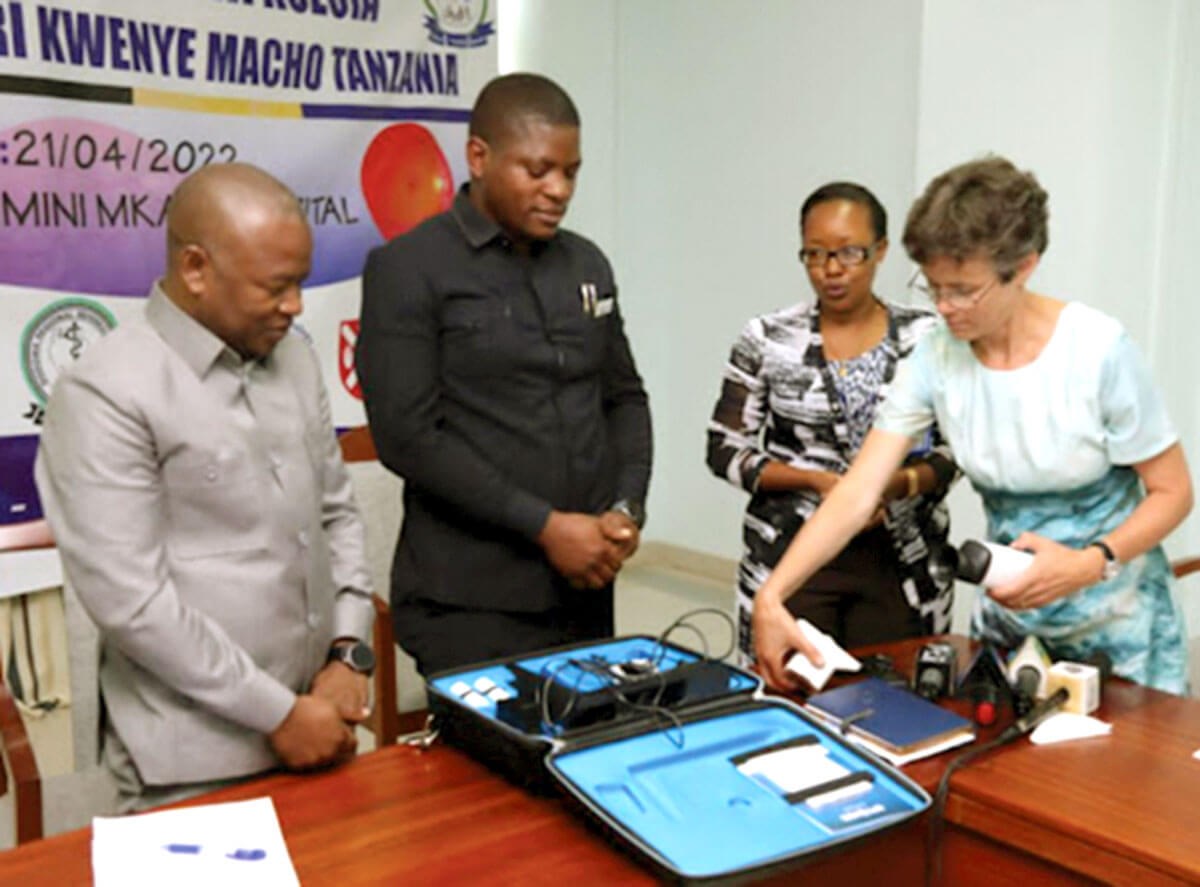
Handover of fundus camera by Rosie Brennan to the Director of Curative Services Omary Ubuguyu at the
Ministry of Health (left), with the Director of Benjamin Mkapa Hospital, Alphonce Chandika (second left).
Bernadetha Shilio, the National Eye Care Program Manager for Tanzania, enabled us to get good publicity on TV, newspapers, and blogs. Omary Ubuguyu, Director of Curative Services from the Ministry of Health, attended the ceremony of handing over the donated portable fundus camera that took place at Benjamin Mkapa Hospital. This ceremony was also attended by members of the press and helped in informing community members of the availability of diabetic retinopathy (DR) screening services at Benjamin Mkapa Hospital. Availability of the fundus camera at Benjamin Mkapa is a big step for the country as it will serve people from the central part of Tanzania.
b) Mbeya
This year I went back to Mbeya. I was last there in 2018 as part of the DR-NET programme and the LINK between Northern Ireland and Mbeya [4-6]. With the help of this previous input, diabetic eye screening and treatment is underway in Mbeya. I collaborated with Rajabu Mlaluko, a doctor working in the department, to audit the findings, and he has since presented them at the All Eye Health Workers Congress in Tanzania.
There is a low take-up of laser treatment, despite 17% of patients screened having proliferative diabetic retinopathy. At a team meeting we identified a number of reasons for this and some changes that could be implemented to try and increase the take-up rate. It is unfortunate that the Swahili word for laser, ‘mionzi’, also means ‘radioactive’, which can deter patients. There is a need to counsel patients to overcome their fears, and for leaflets and flyers that describe the procedure. Other areas to achieve improvement were better communication of grading outcomes to doctors, and training more staff in laser panretinal photocoagulation (PRP) delivery using Reti Eyes [7].
Hopefully next year an audit will demonstrate more patients successfully counselled and agreeing to attend and then receiving adequate treatment for DR.
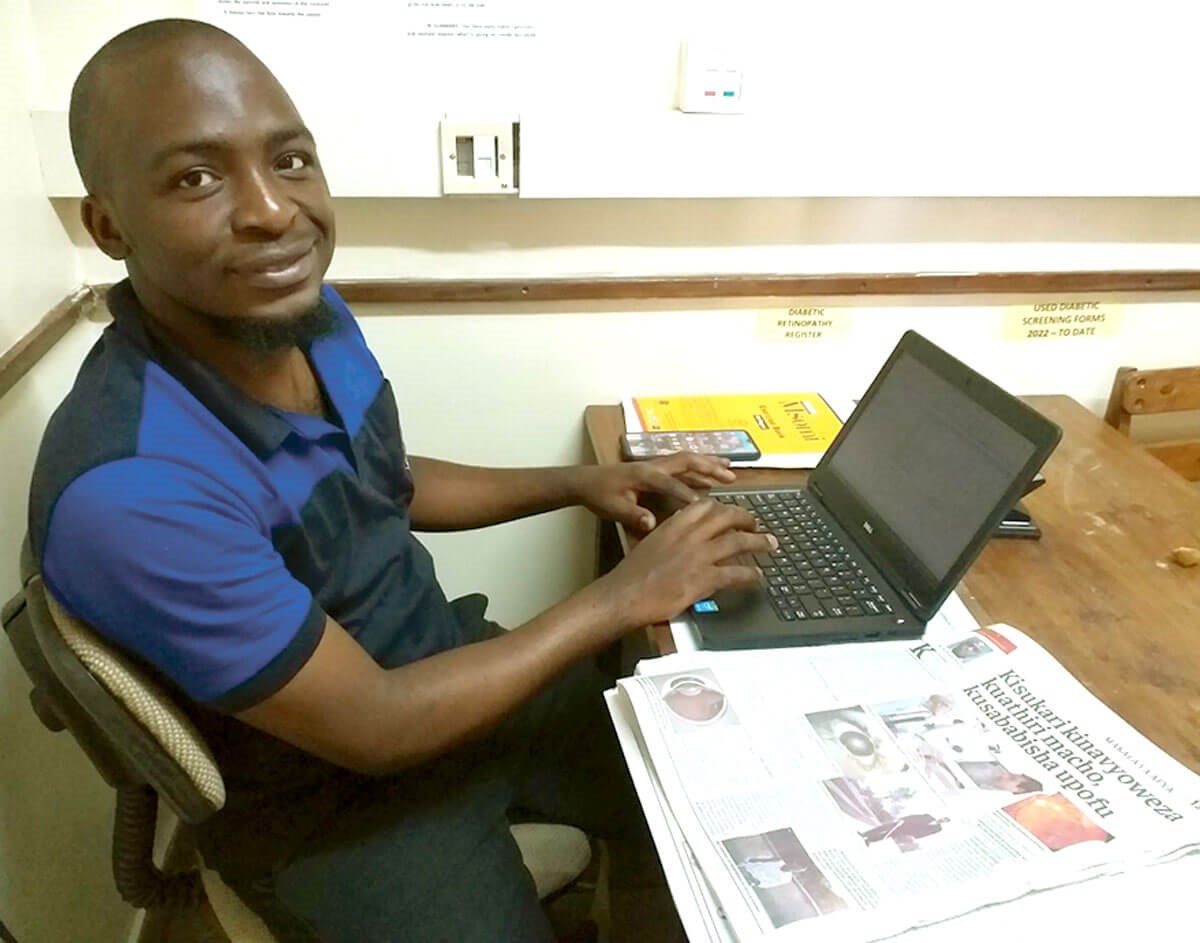
Rajabu Mlaluko auditing the diabetic grading outcomes in Mbeya. He frequently writes articles on
eye health and included in the photo is his newspaper article on diabetic eye disease.
It has been valuable to visit five eye units and see what happens in different departments and be able to share the advantages and disadvantages of these approaches with other units. We are now applying for another Esther grant to get a portable fundus camera for the Mbeya region so that diabetic screening can be carried out at outreach clinics.
In Mbeya it was good to see that the areas the VISION 2020 LINK had focused on had been soundly embedded: the WHO checklist and excellent sterility in theatre, accurate visual acuity measurements in children with cycloplegic refractions and amblyopia treatment, strabismus assessments and surgeries. To work alongside the team in Mbeya and help them to bring about lasting change took time, multiple training visits between teams in both directions (Northern Ireland to Mbeya and vice versa) and a strong commitment on both sides of the LINK partnership.
c) Mwanza
At Bugando Medical Centre in Mwanza the team were keen to get cryotherapy started for children with retinoblastoma. They also requested help working on aspects of glaucoma including assessment of discs, visual fields and interpreting optical coherence tomography (OCT) printouts. Few government hospitals have an OCT machine, but some patients get this done privately and staff were keen to know how to interpret the results. Two of the centres, with my help, started to do their own B scans.
In theatre I taught squint surgery including inferior oblique myectomies and the Crouch procedure. Lateral and medial canthal slings were useful approaches to share in a variety of situations, including congenital imbrication of the eyelids, trauma, and ectropion. Some surgeons were keen to work on perfecting a capsulorrhexis and in-the-bag lens implantation. While small incision cataract surgery (SICS) is the mainstay approach to cataract removal, phacoemulsification will soon be available in Mwanza as part of the new eye building being built for Bugando Medical Centre.
Plans for 2023
Key areas of focus for my training visit next year will again be diabetic screening and treatment. I have ongoing email and WhatsApp chats about treatment of challenging patients, and trainees are involved in submitting case reports to meetings. I am networking with others from Scotland who are involved in simulation training projects and research in Tanzania so I can share even more learning with the centres next year.
But for now, my daily focus is back with NHS patients, and managing patients remotely as I move between the Highlands and Islands. A Global Citizen post is a privilege. It certainly provides the challenge and diversity I was hoping for when I took it on two years ago.
How you can be involved
The VISION 2020 LINKS and DR-NET team would love to hear from you if you are an experienced DR practitioner - ophthalmologist, nurse, grader etc. - and would like to participate in training and capacity-strengthening activities in Tanzania or the other countries where DR-NET works. There are opportunities for working virtually or in person, and it is easy to contact the team to find out more [8]. The LINKS Programme and DR-NET are entirely funded by charitable donations and grants; as well as offers of time and expertise, financial support is always needed.
References
1. iTAT.
https://www.gregcourses.com/
test-and-training
2. Esther Ireland.
https://www.esther.ie/
3. GREG International Certificate training.
https://www.gregcourses.com/
4. DR-NET.
https://www.dr-network.org/
5. Astbury N, Burgess P, Foster A, et al. Tackling diabetic retinopathy globally through the VISION 2020 LINKS Diabetic Retinopathy Network. 2017. EyeNews.23(5):30-4.
https://www.eyenews.uk.com/features/
humanitarian/post/tackling-diabetic-retinopathy
-globally-through-the-vision-2020-links
-diabetic-retinopathy-network
6. Brennan R, Abuh S, Mshangila B, Zondervan M. A three-way partnership between Nigeria, Tanzania and Northern Ireland. Eye News.22(1):40-1.
https://www.eyenews.uk.com/features/
humanitarian/post/a-three-way-partnership
-between-nigeria-tanzania-and-northern-ireland
7. Reti Eye practice tool.
https://www.aurolab.com/retieye.asp
8. Contact - DR-NET
https://www.dr-network.org/contact/
[All links last accessed August 2022].
COMMENTS ARE WELCOME



